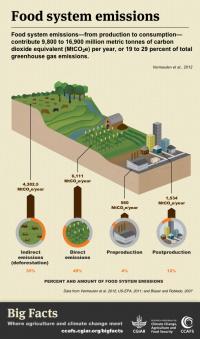Greenhouse gas hotspots, boiling points, and thinking outside the…egg carton

by Neil Palmer
Every once in a while you hear a stat that’s potentially a game-changer.
And if I’m perfectly honest, I really wasn’t expecting it during Roundtable Discussion Seven, “Achieving Emissions Reductions: new tools, technologies and practices across the agro-food chain,” at Agriculture, Landscapes and Livelihoods Day 5.
The aim of the session was to showcase some of the new ways of calculating the greenhouse gas emissions in various food production systems, in order to make the most effective interventions.
And that’s when one of the panelists and presenters, Simon Aumônier, of UK firm Environmental Resources Management, stepped up to the podium.
Simon has been doing a lot of work on the greenhouse gas hotspots of a range of food products over the course of their life cycles. That means he tries to establish which part of the journey from seed to plate results in the most GHG emissions.
An example he gave was maize – one of the world’s most important and most widely-grown food crops. A study by ERM revealed that almost the entire GHG footprint of maize comes from… any guesses?
Fertiliser.
I wasn’t expecting that.
Specifically, 61% comes from fertiliser production – including the extraction of minerals and delivery to farmers; a further 31% comes from fertilizer application and – more significantly – from the natural process of nitrification, during which nitrogen in the fertilizer is converted into nitrous oxide, a greenhouse gas 300 times more potent than carbon dioxide. So that’s a whopping, show-stopping and potentially game-changing 92% of GHG emissions coming either directly or indirectly from fertiliser. That’s not just a hotspot – it’s positively boiling
So let’s think about this. Based on these findings, the obvious response, surely, for reducing the greenhouse gas footprint of maize, is either reduce chemical fertiliser use, or go completely organic. Right?Wrong. For Simon, one of the options was, in fact, applying more chemicals, “crop protection” chemicals specifically, meaning herbicides, pesticides and fungicides. At current levels these only contribute about 1% to the GHG footprint of maize.
By focusing on crop protection, you’re insuring against losing the investment you have made in your crop, and ensuring the greenhouse gas footprint was not left in vain – at least you’re not going to lose your whole field to weeds, bugs or fungi and be forced to start over.
This kind of lateral thinking of course poses some problems: earlier in the session we’d heard how smallholder rice farmers in Bangladesh apply around 40% too much fertiliser, and that even in high-tech systems in developed countries, farmers have very little access to reliable information about the efficient use of inputs. There might well be GHG emissions savings to be made elsewhere, rather than applying more chemicals.
All Simon was pointing out was that the new analyses bring into focus some possible new entry points for tackling the problem, but he acknowledged that the hunt for solutions was not necessarily going to be easy.
To illustrate, he later mentioned the humble chicken’s egg. During research he carried out for a major UK food retailer, it turned out that in the UK, the kind of egg with the lowest carbon footprint was in fact…
Organic! Nope.
Free-range? Wrong again.
The answer?
Battery eggs, you know, the ones routinely plopped out by miserable hock-burned foul over the course of a lifetime that is invariably nasty, brutish and pretty damn short.
Even with the processed feed concentrates and the antibiotics the lighting and everything? Really, battery eggs? At the end of the session, I sprung off my seat to find out how it could possibly be true.
“Battery eggs come from an optimised production system,” he told me. “The worst kind of eggs you can buy – from an environmental perspective – are free-range. The birds live longer than battery hens, so they need more food and water, for example. They’re also more prone to disease.”
Every egg from every pious, benevolent and supposedly “happy” chicken I’d ever eaten flashed before me. But for Simon the results didn’t mean we should abandon animal welfare in pursuit of emissions reductions, and he himself confessed to eating free-range eggs.
Instead, it means that as we develop new tools and methods for pinpointing the source of GHG emissions, we might find ourselves having to make some unexpected trade-offs.
“Some of these conundrums go beyond agriculture itself,” he said. “There’s a lot of really complex stuff to consider; there’s no simple algorithm. We just have to do what we can.”
Neil Palmer is a Outreach Public Awareness Officer at the International Center for Tropical Agriculture (CIAT). Follow the latest developments from the UN climate talks in Doha on our blog, on twitter @cgiarclimate and #ALLForest